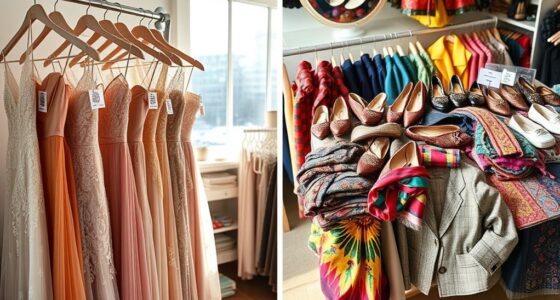Sustainable fashion for kids and teens combines eco-friendly fabrics, like organic cotton and recycled materials, with ethical manufacturing practices that guarantee fair wages and safe conditions. These clothes protect your child’s health by avoiding harmful chemicals and support responsible farming to reduce pollution. Plus, they’re stylish, durable, and promote eco-conscious habits. If you keep exploring, you’ll discover how choosing sustainable options can make a positive difference for your family and the planet.
Key Takeaways
- Eco-friendly fabrics like organic cotton and recycled materials reduce environmental impact and promote sustainable farming practices.
- Ethical manufacturing ensures fair wages, safe conditions, and transparency in supply chains for kids’ and teens’ clothing.
- Sustainable production methods use eco-dyes and energy-efficient processes to lower waste and carbon footprints.
- Eco-conscious fashion options are stylish, durable, and teach children about caring for the environment.
- Supporting sustainable brands encourages conscious consumption and a greener future for younger generations.

As more families become aware of environmental impacts, sustainable fashion for kids and teens is gaining popularity. You want to make choices that protect the planet while still dressing your children in stylish, comfortable clothes. One of the key ways to do this is by choosing garments made from eco-friendly materials. These materials are produced with minimal environmental impact, often using organic cotton, bamboo, or recycled fabrics. They don’t rely on harmful chemicals or pesticides, which means fewer toxins end up in the soil and water. When you opt for eco-friendly materials, you’re not only reducing your child’s exposure to potentially harmful substances but also supporting farming practices that conserve resources and promote biodiversity.
Choosing eco-friendly fabrics protects children’s health and supports sustainable farming practices.
But it’s not just about what the clothes are made of; how they’re made matters just as much. Ethical manufacturing ensures that workers are treated fairly and paid just wages. When shopping for sustainable kids’ and teens’ fashion, you want brands that prioritize transparency and uphold fair labor standards. These companies often work in safe environments, avoid child labor, and implement fair wages throughout their supply chains. By supporting ethical manufacturing, you’re helping to combat exploitative labor practices and promote a more just global fashion industry. It’s about making sure that every step — from harvesting raw materials to final product delivery — aligns with your values.
Choosing sustainable fashion also means paying attention to how clothes are produced. Brands committed to sustainability often use eco-friendly dyes, reduce waste, and implement energy-efficient practices in their factories. These efforts lower carbon footprints and lessen pollution, making your purchase a conscious choice that benefits the planet. Additionally, many companies are working towards reducing textile waste, which is a significant issue in the fashion industry. When you buy from brands that prioritize ethical manufacturing, you’re encouraging better industry standards and promoting social responsibility. It’s empowering to know that your child’s clothes are made with respect for both people and the environment.
Incorporating sustainable fashion into your family’s wardrobe doesn’t mean sacrificing style or comfort. Many brands now produce trendy, durable pieces that are environmentally friendly and ethically made. By making informed choices, you teach your kids the importance of caring for the world around them. Over time, this mindset can influence their preferences and habits, fostering a generation that values sustainability. Ultimately, your decisions can contribute to a more sustainable future, one outfit at a time.
Frequently Asked Questions
How Can Parents Teach Kids About Sustainable Fashion?
You can teach kids about sustainable fashion by involving them in educational activities like sorting clothes by eco-friendly materials or researching brands committed to sustainability. Encourage good shopping habits, such as choosing quality over quantity and opting for secondhand stores. Talk openly about the environmental impact of fast fashion, and make it fun by involving them in clothes-swapping or DIY projects, helping them understand the importance of mindful consumption.
What Are Affordable Sustainable Fashion Brands for Kids?
You can find affordable sustainable fashion brands for kids that use organic cotton and recycled fabrics. Brands like Mini Rodini, Patagonia Kids, and Frugi offer stylish, eco-friendly options without breaking the bank. Look for labels that prioritize organic materials and recycled fabrics to guarantee you’re making a sustainable choice. Shopping during sales or at outlet stores can also help you save money while dressing your kids sustainably.
How Does Sustainable Fashion Impact Children’s Health?
You might not realize it, but sustainable fashion can dramatically protect your child’s health. By prioritizing chemical safety, you drastically reduce exposure to harmful toxins that can cause allergies or even long-term health issues. Choosing eco-friendly fabrics prevents skin irritation and allergy risks, making a huge difference. Your child’s skin and overall well-being benefit immensely, ensuring they grow up healthy, safe, and free from chemical-related health concerns.
Can Sustainable Fashion Be Suitable for Active or Sportswear?
Yes, sustainable fashion can be appropriate for active or sportswear. You’ll find performance fabrics made from recycled materials that wick moisture and offer stretch, perfect for workouts. Eco-friendly dyes ensure vibrant colors without harmful chemicals, keeping the garments safe for wear. By choosing sustainable activewear, you support eco-conscious brands that prioritize both performance and environmental impact, making your active lifestyle more eco-friendly and stylish at the same time.
What Are Eco-Friendly Textile Options for Kids’ Clothing?
You should look for eco-friendly textile options like organic fibers and recycled textiles for kids’ clothing. Organic fibers, such as organic cotton and hemp, are grown without harmful chemicals, making them safe for children. Recycled textiles repurpose materials like plastic bottles or fabric scraps, reducing waste. These options are durable, comfortable, and environmentally responsible, helping your kids stay stylish while supporting sustainability efforts.
Conclusion
By choosing sustainable fashion for kids and teens, you’re helping create a better future—one where style doesn’t come at the planet’s expense. Remember, even as you scroll through social media, your choices matter. Think of it like the first computer, a simple start that led to incredible innovation. With each eco-friendly purchase, you’re making a difference, proving that small actions today can shape a more sustainable world tomorrow.









